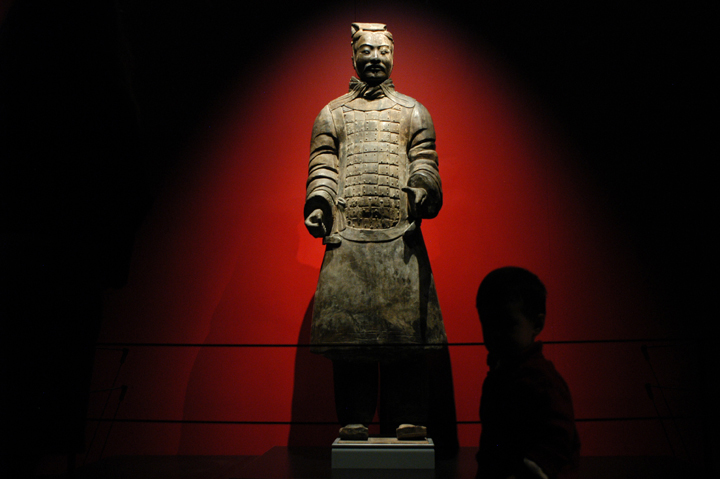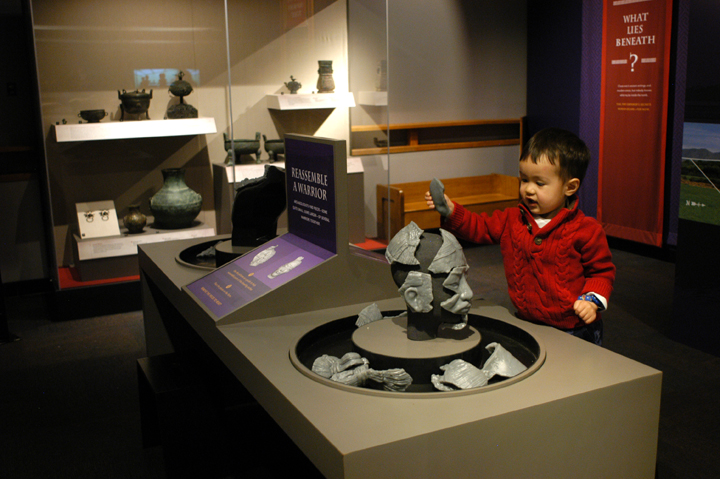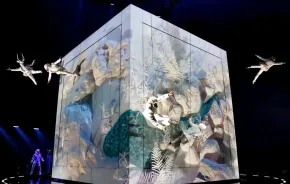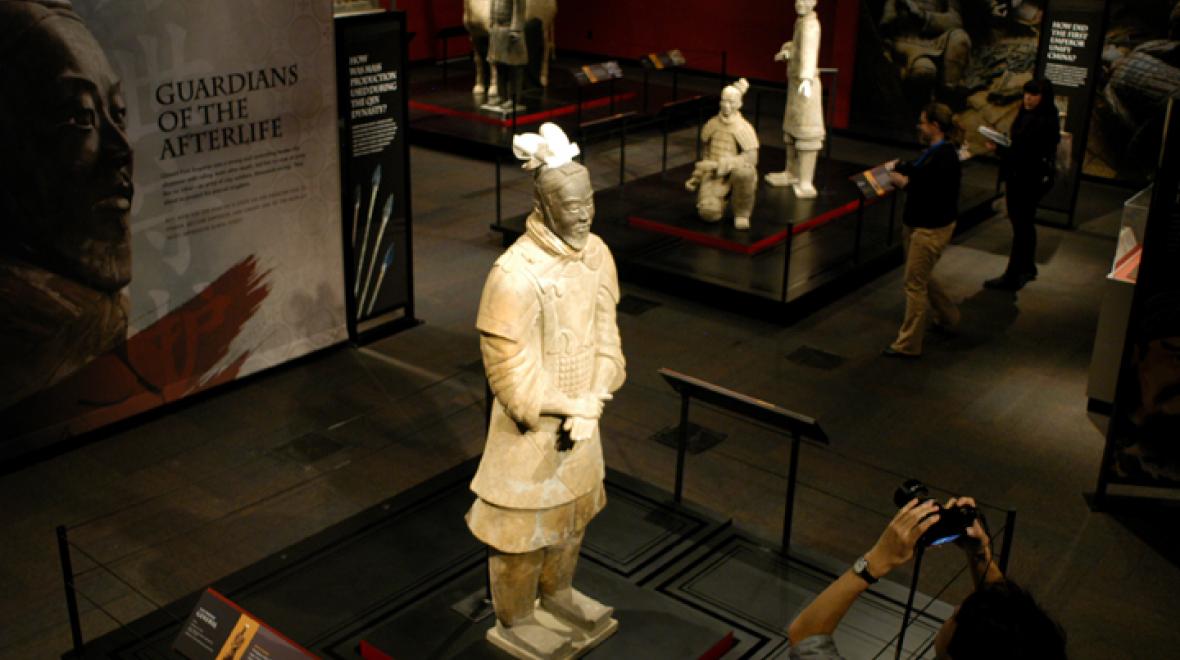
Photo:
Statue of a general at Pacific Science Center’s Terracotta Warriors exhibit. Photo credit: JiaYing Grygiel
In 1974, farmers digging a well near Xi’an, China, discovered one of the biggest archaeological finds ever: 8,000 terracotta soldiers buried in a 22-square-mile area beneath their fields. The clay army surrounded a tomb for Emperor Qin, who ruled China some 2,200 years ago.
Terracotta Warriors of the First Emperor, a new exhibit at the Pacific Science Center (PSC) that is on view through Sept. 4, includes more than 100 artifacts. The real stars are the 10 life-size clay figures, including a general, two archers, a charioteer and a musician. Described as "one of the most epic discoveries of our time," the exhibit is on a two-city tour in the U.S., with the world premiere in Seattle.
“Basically, we’re telling a story,” said Diana Johns, vice president of exhibits at PSC. “We’re letting these statues tell a story about the emperor, about the times, about the people who made these warriors, what life was like during the time of the emperor.”
Through the display of the warriors and the artifacts, the exhibit also looks at the many technological advancements of Emperor Qin's time. Also known as Shihuangdi, which translates to "first emperor," he united the country, standardized currency, language and measurements, and built roads and canals.
But, as Johns pointed out, he was “definitively not a warm and fuzzy kind of guy.” He needed a lot of warriors around him for protection. This terracotta army was meant to eternally guard Emperor Qin’s tomb, which is still sealed, and go with him to the afterlife. The exhibit also looks at the science of excavation, and the mysteries of the sealed tomb and what might be inside.
|
|
|
Statue of an armored officer at the start of Pacific Science Center’s Terracotta Warriors exhibit. Photo credit: JiaYing Grygiel |
Journeying to Xi'an, by way of Pacific Science Center
The exhibit begins with a three-minute video summarizing the terracotta warriors’ historical context. All 10 of the life-size figures are located on the main level.
After viewing the ancient terracotta warriors in the main gallery, visitors can enter a tunnel that’s filled with replicas. It’s an immersive experience designed to evoke a dirt pit under torchlight, when the warriors were moved in 2,200 years ago. As you walk through, you see the warriors first in their original painted state, then slowly fading and falling apart, to recreate what happens to artifacts with the passage of time. The tunnel was a highlight for our family, but if it’s overwhelming for your kids, there is a pass-through so you can skip it.
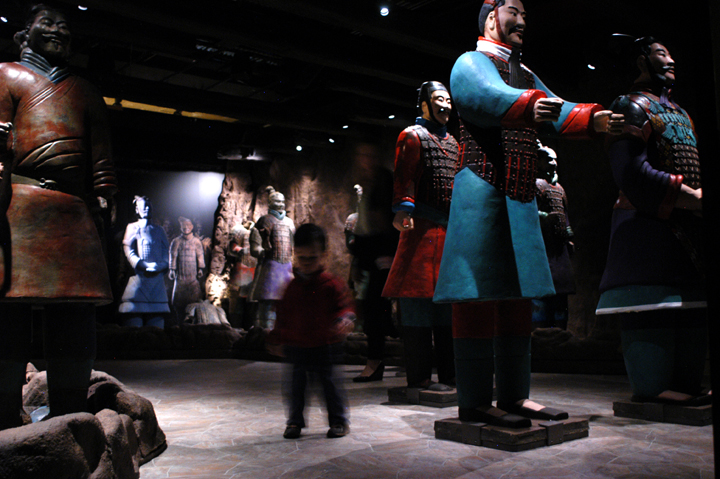 |
|
Inside the immersive experience with painted replicas at Pacific Science Center’s Terracotta Warriors exhibit. Photo credit: JiaYing Grygiel |
After you exit the tunnel, head upstairs. Along the ramp, banners describe the enormity of this archaeological find: 2.4 million pounds of clay! Almost 2,000 warriors excavated so far! The upper level includes some smaller artifacts, an interactive puzzle and a model of the emperor’s tomb. The exhibit deposits you into the gift shop where you can take home a miniature terracotta warrior ($24.99) and other trinkets loosely tied to China (stuffed panda or tea, anyone?).
The exhibit includes a few interactive activities, such as assembling a warrior with different body parts. Families can help each other piece together a head or a shoulder of a warrior, giving kids a taste of what the archaeologists went through. None of the warriors were found intact, and putting them together was akin to an intense puzzle.
Walking through the exhibit space, you get a strong sense of history. Each warrior stands 6 feet tall, and each one has a uniquely sculpted face. The terracotta statues aren’t as chilling as the body casts from PSC's Pompeii exhibit, but these figures were meant to go to the afterlife.
|
|
|
An interactive feature piecing together a warrior’s head at Pacific Science Center’s Terracotta Warriors exhibit. Photo credit: JiaYing Grygiel |
Tips for taking kids to Terracotta Warriors
The show is recommended for kids 6 and older, for good reason. There are a few interactive stations, but most of the exhibit is do not touch, so it could be challenging for high-energy, grabby kids. To prep older kids, you could see IMAX movie, Mysteries of China, at the Pacific Science Center (see more on that below).
If you bring preschoolers, ask for an activity bag to use in the special exhibit area. It’s filled with things they can touch: a measuring tape, a Magna Doodle board, color paddles and a board book.
Here are some ideas for exploring that (slightly creepy) story of terracotta warriors with kids:
- Encourage making discoveries. The burial site was discovered by farmers digging a well. No one had any idea it was there. Kids should think of themselves as scientists, even when they are digging in their backyards. “They have the power to make future discoveries as well,” said Andrea Rockwood, interpretive programs supervisor at PSC. “You never know where you’re going to find something that’s incredibly meaningful and significant.”
- Play “I Spy.” There’s a lot of detail in the artifacts, and a huge part of being a scientist is making observations. Look for a tiny gold tiger ornament, a life-size horse statue and the faces of all the warriors (they are all different). “There’s a real reward for looking at things closely,” Johns said.
- Ask, “What will you do when you are 13?” Emperor Qin became king at age 13. Talk about what your kids will be doing at age 13. Going to middle school? Playing soccer? Ruling a country?
The mystery of the tomb
The exhibit ends with the big mystery: What’s in the emperor’s tomb? An early Chinese historian describes a lavish underground tomb complete with a recreation of his empire and rivers full of mercury (another reason is hasn't been excavated). The final room of the show re-creates the appearance of the tomb to get you thinking about what’s inside.
“I love it,” Johns said. “It’s my favorite part of the exhibit. You can’t Google it, you have to wait.”
Bottom line: If your kids can navigate a less-interactive exhibit, are older or are interested in history, then do go. There’s no substitute for standing directly in front of a clay soldier from China’s first imperial dynasty. The tickets aren't cheap, but it's a lot cheaper than a family trip to Xi’an.
If you goWhat: Terracotta Warriors of the First Emperor” at the Pacific Science Center runs from April 8 to Sept. 4 Tickets: Purchase tickets online for a specific time. Cost is $32.75/adults, $30.75/seniors, $27.75/ages 6-15, $24.75 (ages 3-5), and $12 for members of all ages (it might be a good time to think about a Pacific Science Center membership). A handheld audioguide ($6 general public, $4 members) narrates in English, Spanish and Mandarin. Parking: The Science Center’s garage is located on the corner of Second Ave. N. and Denny Way. $9-$13. Because of crowds, consider taking the bus. Parents should know: No food, drink or double-wide strollers are allowed in the special exhibit area. There are no restrooms inside. You can bring in a backpack if you wear it in front. IMAX movie: To prep older kids for the exhibit, you could see IMAX movie, Mysteries of China, at the Pacific Science Center, which helped me understand the context of the warriors. Note: the movie is terrific for history buffs, but not designed for young children. In the middle of the movie, my 5-year-old asked (loudly): “How come it’s so long?” Learning more: It’s helpful to study the Terracotta Warriors before visiting the special exhibit. Read PSC's guide for teachers and brochure for students. More at Seattle Center: Find much more to do at Seattle Center. |




